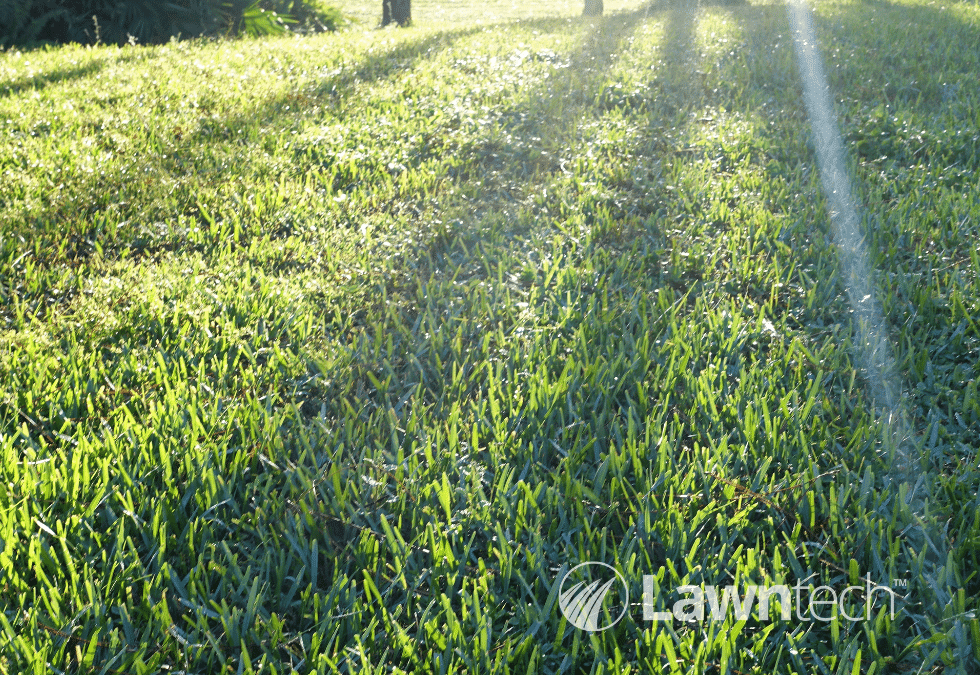It’s not uncommon for lawns to have shaded areas depending on the position of your house and property or garden features including trees and shrubs. Unfortunately, however, most grasses found in the UK don’t do very well in the shade.
Many UK homeowners will have experienced those awkward shady lawn areas and know just how difficult it can be to grow a healthy grass there. Most species of grass require sun to grow well so without sufficient light to sustain itself, shaded grass often grows poorly and can become very sparse.

Whether you are a homeowner or a property manager, you’ll likely already know that shady lawns are tricky to maintain.
So, how do you grow a lawn in the shade?
This can certainly be a real challenge, especially when your lawn is in constant shade. Your grass plants rely on sunlight to gather simple molecules from the environment and transform them into the food they need to grow. That lack of food and nutrients can make your lawn vulnerable and so more susceptible to disease, mould, and moss.
However, don’t let the shade dull your sunshine, there a few things you can do to ensure you get the best out of your shady lawn:
Trim shrubs and hedges
Tall shrubs and hedges are often a common cause for shaded areas in your garden. So trim back your own shrubs and hedges to allow for sunlight to reach areas that these features would usually hide. We recommend you prune ornamental shrubs in winter, while the plants are dormant and again in spring/summer immediately after flowering.
Thin overhanging branches
Overhanging branches can shade areas that could receive sunlight. Depending on the tree type, you should prune in early spring or at the end of summer. Make sure to check for nesting birds before pruning. If you do encounter birds nesting in your branches, wait for them to move on first.
Do take advice from a horticulturist regarding plants like fruit trees before trimming.

Allow more sunlight to penetrate to ground level by pruning shrubs, hedges and trees.
Be water wise!
It’s important to be aware that there are two styles of shade: dry shade and damp shade. A lawn too wet will encourage disease whilst a lawn too dry will die of thirst. Manage the water by manging the soil and aerate shady lawns regularly to assist nutrient efficiency and help water penetration.
In areas of lawn that are shaded by trees the tree roots will be demanding most of the water. This means the soil can become dry very quickly. Ensure you water thoroughly under trees to provide your grass with sufficient coverage.

If you sow or lay a lawn in a shaded area with insufficient water, it’s likely the lawn will fail.
Be mindful of mowing
Consider your mowing routine when caring for a shaded lawn. We recommend mowing the lawn less frequently and on a higher setting so the grass pant leaf can absorb sufficient light. Make sure to remove grass clippings to prevent further shade.

Mow lawns in shade less frequently, as the grass will grow less quickly.
Remove moss from your lawn
Moss is likely to thrive in shady areas as whilst your grass thins out, moss creeps in. Treat moss in your lawn or rake it out to prevent moss taking over and causing further damage. Lawntech uses a special blend of liquid iron with trace elements and wetting agents which, not only effectively controls moss, but hardens and conditions the grass plants throughout the winter.
Find out more about our moss control here.

A lawn in shaded areas can become weak and vulnerable making way for moss to creep in. Control moss in your lawn to prevent it taking over.
Overseed for a thicker sward
Regularly overseed in warm, damp conditions as this will help the sward to stay thicker and promote a healthier growth.
Give your lawn a helping hand and feed frequently
Ensuring your lawn receives the correct nutrients it needs to thrive is key to promoting a healthy growth. Lawntech can tailor an annual lawn treatment programme to suit your lawns needs.
Where shaded lawns lack sunlight, fertiliser will feed your lawn a healthy balance of nutrients at the appropriate time of year to encourage strength and growth.

Feed your lawn the nutrients it requires to help promote a healthy growth.
At Lawntech, our team of lawn care experts will work with you to find the best solutions for your lawn. Contact us today to find out more or receive an instant, no obligation quote to your email address using our handy online measuring tools.



